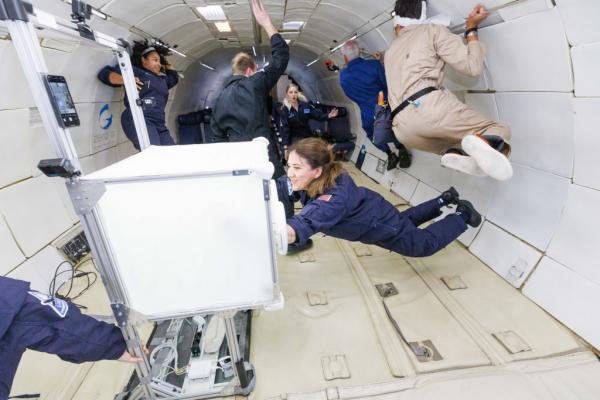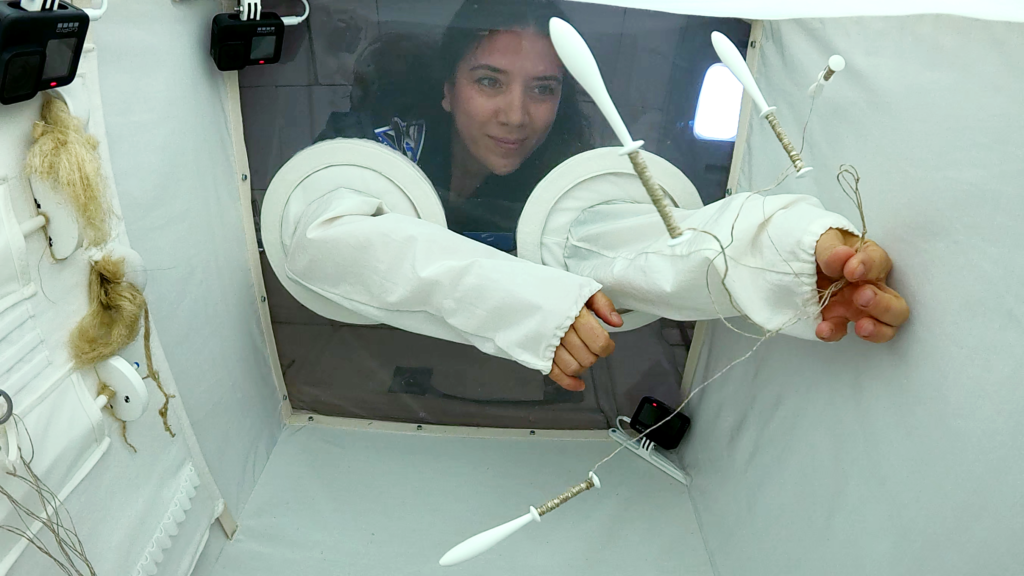Last summer, Art + Technology Lab grant recipient Ebru Kurbak’s Reinventing the Spindle received SIGGRAPH’s Art Gallery Best in Show award. With the additional support of MIT’s Space Exploration Initiative, the artist performed microgravity and low-gravity investigations of textile production and used these experiments as a basis for greater conversation around the ramifications of space colonization. Upon the occasion of the award, SIGGRAPH’s Rylee DuVall talked with Kurbak about the project’s development and fruition. The full version of this Q&A is featured on the SIGGRAPH blog.
Tell us about the inspiration behind your SIGGRAPH 2023 Art Gallery project and Best in Show winner Reinventing the Spindle.
In my practice, I often explore how our biases shape our perception of certain materials, knowledge, and skills. In this particular project, I was inspired by stumbling across the fact that flax (Linum usitatissimum) was one of the first plants attempted to be grown in space on Salyut 1 in 1971. As someone who had worked with hand-spinning flax, I began to imagine how this material could be worked with in weightlessness; however, I could not find any research documentation on working with fibers in microgravity, while many other material experiments such as welding, soldering, glass forming, and 3D printing have been attempted in space. This got me thinking about the politics of research in microgravity and led me to recreate this "missing" experiment 50 years later. I decided to combine one of the oldest earthly technologies, the making of a string, with high-end technology that simulates weightlessness. I took raw fibers and a hand spindle on a parabolic flight and tried to make a thread in conditions that were completely foreign to me.
Why did you decide to have your project tackle the politics of near-space exploration? What challenges did you face in its creation, and how did you overcome them?
Around the time I started thinking about this project, NASA announced that they were opening up the ISS to private research ventures, suggesting that a satisfactory amount of scientific experiments had already been carried out. This made me examine these research projects, and as a result, I asked myself: whose curiosity has been satisfied and whose knowledge has been marginalized all these years? The colonization of space often seems to us to be a distant possibility, and we do not always take it seriously. But the colonization of low Earth orbit is a present reality. I see weightlessness as common and am bothered by the profit-driven first-come, first-served attitude to near space.
There were, of course, many challenges. However, I was fortunate to receive the LACMA Art + Technology Grant and to be supported by the MIT Space Exploration Initiative, who took me on their parabolic flight, and the Austrian Science Fund (FWF) [10.55776/V795]. First, it takes a lot for an outsider like me to get used to the idea of going on a parabolic flight. Planning the experiment was also not easy. I spent two years discussing with the team and technical advisors from the flight company. Although most open calls for research in space are intended to be “open to all,” the guidelines are often created with specific types of experiments in mind. So, I decided early on that this research would have a performative character, and as such, the process of negotiating the guidelines would become an essential part of the project. As a manifestation of this process, I hand-made a unique zero-gravity experimentation booth in which I conducted the experiments.
This installation builds on the knowledge derived from women’s, Indigenous, and nomadic cultures. What drew you to referencing these cultures in your project’s creation?
The answer to this has a lot to do with my personal history. As a woman growing up in Turkey in the 1980s, it was almost a must for me to learn textile handicrafts. My family has nomadic roots going back several generations, bringing with it knowledge of alternative philosophies of relating to the material world. As an artist, I prefer and find it important to work from my situated position. Diversity cannot be achieved by simply inviting people from different backgrounds to work for the same agenda. We need the greatest possible variety of individual positions that have the power to shape research interests, values, and methods to overcome homogeneity.
The Art + Technology Lab is presented by![]()
The Art + Technology Lab is made possible by Snap Inc.
Additional support is provided by SpaceX.
The Lab is part of The Hyundai Project: Art + Technology at LACMA, a joint initiative exploring the convergence of art and technology.
Seed funding for the development of the Art + Technology Lab was provided by the Los Angeles County Quality and Productivity Commission through the Productivity Investment Fund and LACMA Trustee David Bohnett.




